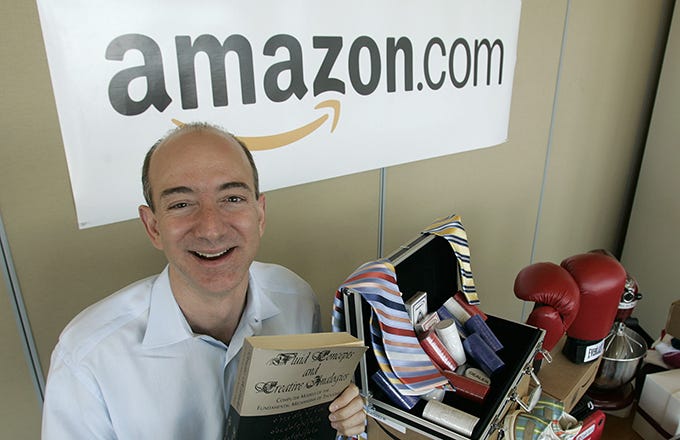
|
When Jeff Bezos founded Amazon.com in 1994, the age of the online-only retailer appeared to be far off.
In August of 1994, The New York Times published an article that opened with the question “Has the Internet been overhyped?” The article cast doubt on figures that stated that 20 million people were using the Web, quoting authorities who said the number was closer to two million, speculating on the consequences awaiting companies that had wasted money on online projects.
Unlike the New York Times, Bezos was bullish about the business potential of the Internet. While rising through the ranks at a meteoric clip at D. E. Shaw in the early ‘90s, he had begun to develop the idea behind Amazon. All that remained was to determine which type of business had the most potential. (For more, see: 10 Facts You Didn’t Know About Amazon.)
One factor that drove Bezos’ ruminations was a then-recent U.S. Supreme Court ruling that mail-order businesses were exempt from sales taxes in states in which the companies didn’t have a physical presence. He started researching mail-order businesses and their products. From there, he winnowed the opportunities down to smaller and smaller lists, finally deciding to get into the book business, because of the millions of titles in print.
He talked the idea through with friends and family, who offered financial and moral support. The details of the business came into focus for Bezos on a cross-country drive from Texas to Seattle. Setting up shop in the garage of his Seattle home, he initially named the business Cadabra.com, as in the magician’s phrase “abra-cadabra,” but later changed it because of its similarity to “cadaver.”
With a new name and a full library of books for sale, Amazon.com opened for business, and the orders began pouring in almost immediately. (For more, see: Amazon Never Makes Money But No One Cares.)
"Within the first few days, I knew this was going to be huge," Bezos said of the launch. "It was obvious that we were onto something much bigger than we ever dared to hope."
In its first two months, the advantages of being online were apparent. Amazon sold books in all 50 states as well as more than 45 countries, bringing in $20,000 in sales per week by late 1995.
Another big advantage to being online was the ability to sell merchandise that was held in the warehouses of book makers and suppliers. That allowed Amazon to offer a nearly infinite inventory, without most of the associated costs.
Bezos knew that the company’s initial success would create imitators and competitors. The keys to Amazon’s survival, Bezos realized early on, would be innovation and size. One reason that he’d chosen the name Amazon is because it's the biggest river in the world. His plan, even though Amazon initially focused on books, was to make the site into the biggest store in the world. (For more, see: 10 Facts You Didn’t Know About Amazon.)
By October 1995, Bezos felt confident enough in the business to seek capital with an initial public offering (IPO), which it completed in May of 1997. Even as it solicited investors, Bezos warned them that he didn’t expect the company to earn a profit for four to five years. Instead, he planned to heavily reinvest all surplus revenue into growing the business.
With low barriers to entry in the online retail market and the number of internet users growing exponentially every year in the mid- and late-‘90s, Bezos motto for Amazon at the time was summed up in three words “Get Big Fast.”
He followed through on that by investing not just in technology and new initiatives, but by purchasing a wide range of competitors, potential competitors and complimentary businesses over the next few years. That investment paid off, and gave the company a leadership position in online retail, a sector that simply didn’t exist ten years earlier. Amazon attained such a level of popularity that Time magazine named Bezos its 1999 Person of the Year.
And while Amazon’s long and winding trek to profitability irked a few investors, the strategy served the company well, especially when the dot-com bubble burst in the beginning of 2000, wiping out a large number of Amazon’s competitors.
By the fourth quarter of 2001, Bezos announced the company’s first profit—a scant $5 million, or one penny per share. But that profit came on revenues of more than $1 billion.
By 2001, the dot-com bubble had burst, and even Amazon had to retrench and reevaluate. The retrenching came in the form of layoffs in which the company shed 1,500 employees. The reevaluation led Bezos to look for ways to diversify Amazon’s business model.
One of the areas of diversification was the Amazon Marketplace, which let Amazon customers sell their used books, and other products alongside Amazon’s own offerings. To date, Amazon’s used-items marketplace is still the largest in the world. (For more, see: How We'll All Be Amazon.com Customers Eventually.)
Ten years after the New York Times doubted that 20 million people used the Internet on a regular basis, there was no denying that it had become a defining force in American culture. By 2004, roughly 60% of U.S. households had i\Internet access, and that number was growing. And Amazon, which now offered a wide array of products from books and CDs to clothing, electronics and more, was uniquely positioned to take advantage of the growing number of Americans who were shopping online. In 2004, Amazon brought in revenues of $6.9 billion, which increased to $8.5 billion in 2005.
In addition to growing, Bezos’ own experience with displacing entrenched industry giants led him to continue to experiment with new business lines and new services. Some, like Amazon’s foray into jewelry, didn’t pan out. But others, such as the Amazon Prime program, succeeded spectacularly. The program, which it introduced in 2005, offered free two-day shipping within the continental United States for a $79 annual fee. The program’s success led Amazon to launch it in Germany, Japan, the United Kingdom, France, Italy and Canada over the next eight years. Prime succeeded in keeping customers loyal and made it even harder for other online retailers to compete.
With its place at the top of the online retail world secure, Amazon began to look into other avenues – one of which was technology development. That business began, as had Amazon, with books. The Amazon Kindle, introduced in 2007, was a lightweight device for reading electronic books that was largely responsible for the creation of the e-book market in the U.S. and abroad. (For more, see: An Overview of Businesses Owned by Amazon.)
Four years later, Amazon entered the tablet market with the Kindle Fire, a low-cost alternative to the iPad, which was seen by many as a deliberate loss leader to help the company sell its vast catalogue of digital content.
Those new businesses, along with forays into smartphones, groceries, television series, cloud storage, aerial drones and social networking made Amazon not just the biggest online retailers in the business but one of the premier tech companies in the U.S. With 2014 revenues of $88.8 billion, it’s also made Bezos and Amazon a lot of money.
Jeff Bezos: Net Worth
-
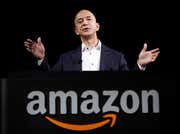 Insights
InsightsJeff Bezos Nets Almost $1 Billion in Amazon Stock Sale (AMZN)
Jeff Bezos gets richer by almost $1 billion by selling Amazon shares at record high price. -
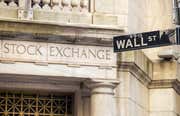 Insights
Insights7 Worst Products Amazon Ever Had (AMZN)
Amazon's Jeff Bezos believes that great successes are built on big failures. Amazon has plenty of failures, including some costing more than $100 million. -
 Insights
InsightsAmazon: 10 Secrets You Didn't Know (AMZN)
10 little-known facts about e-commerce leader Amazon.com Inc., the world's largest online provider of retail goods led by Jeff Bezos. -
 Investing
Investing4 Takeaways From Bezos' Annual Letter
The Amazon CEO's annual shareholder letter contains nuggets of wisdom about building companies and always remaining in Day 1 mode. -
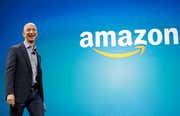 Insights
InsightsJeff Bezos Biography
Jeff Bezos is an American online retail pioneer and tycoon, with a net worth of $58.8 billion in November of 2015, according to Forbes. As founder and CEO of Amazon.com, he changed the way Americans ... -
 Managing Wealth
Managing WealthIs Amazon Too Diversified?
Amazon recently posted an unexpectedly large profit. But is the company too diversified for its own good? -
 Investing
InvestingSales Are Up, Revenue Is Up, So Why Is Amazon Down? (AMZN)
Whether it's because of an inefficient stock market or great internal problems, Amazon's stock is down significantly in 2016 despite record profits. -
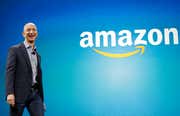 Investing
InvestingBezos Sells $1.1 Billion Worth of Amazon Stock
The retail giant's founder and CEO has been periodically selling shares to turn his mounting wealth into cash ready to fund new ventures. -
 Investing
Investing10 Facts You Didn’t Know About Amazon (AMZN)
Amazon's market cap crossed the $1T threshhold on Sep 4., 2018. Here are some fun facts about the world's "most customer-centric" company.


